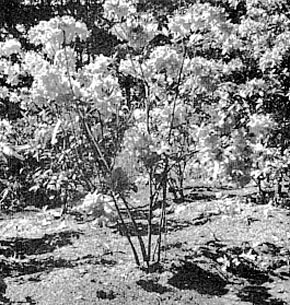QBARS - v11n4 The Results of the Intercrossing of Some Azaleas from Exbury
The Results of the Intercrossing of Some Azaleas from Exbury
By John Henny

|

|
|---|---|
Fig. 36. Seedlings of R. 'Cecile x R. 'Berryrose' R. Henny photo |
Fig. 37. Seedling of R. 'Klondyke' x R. 'George Reynolds' R. Henny photo |
When I first visited the Exbury Gardens ten years ago I missed the bloom of many early hybrids and species rhododendrons due to the lateness of my trip. Yet the most impressive sight I saw was a planting of large deciduous azaleas, finer in color, size and form than any that I had ever seen. Upon my return, and within the next year we imported 46 layers from the Exbury Gardens, all clonal named forms.
Within the next two seasons we made a few crosses, and selfed a number of the fine clones with the hope of getting even finer bloom. We kept careful records, and each bloom to be crossed was emasculated before it opened, and later when pollen was applied it was tagged, in this way we were almost sure that the results could be of value in the future as a guide or at least as a record. Up to this date we have made 21 crosses and bloomed 13 of them. In all we have bloomed 5000 plants. Some have been fine, and I am sure they will prove their worth in years to come, others have been no improvement on the parents, and the third group have been of no value, these are mostly small bloom much reminiscent of the poorest forms of species from the eastern coast of the United States.
This spring for the first time we had quite a number of seedlings flower. There were in this group a few exceptional first bloom and this will be in a future report after another season. We are of the opinion that some of these will be well worth naming. We were working for large flowered pinks and in this we were disappointed as the colors varied in shades of pink and the rest were white, but the best of these were white with pink edges and lobes some with ivory, yellow and salmon. About 15 per cent of the seedlings were pure white, we were quite pleased with the quality of the blooms as well as the size and width. As to the pinks mentioned above they followed quite closely to what we had expected in color, but the run of pinks was not over 25 per cent.
R. 'Cecile' a large flowered salmon pink was the parent of many of the crosses we made. There is one difficulty in that this variety does not readily set seed if selfed and we had to make a large number of self crosses to get just a little seed. R. 'Cecile' does readily cross with other pinks. The first cross we flowered by using 'Cecile' as a parent flowered some years ago and it was the cross 'Cecile' x 'Berryrose'. 'Berryrose' being another pink with a yellow blotch. The offspring of this cross were disappointing and none have as yet shown much promise. We had high hopes when we made the above cross, as we have now for the cross 'Cecile' x 'Strawberry Ice' which will bloom this spring.
R. 'Basilisk' was also self pollinated, and these were equally as good as the seedlings out of 'Cecile'. The bloom was large for the most part, and of good substance with a much wider color range from sulfur yellow to ivory and pure white, some white with yellow blotch. The seedlings of this cross ate not quite as strong and vigorous as they might he. The cross 'Basilisk' X 'Princess Royal' had many large flowered pinks fading to white. These seedlings are much stronger and show great vigor.
R. 'Klondyke' self pollinated produced many seedlings that were as 'Klondyke' as 'Klondyke' itself. There was no variation here, and all were about the same color as the parent. 'Klondyke' x 'George Reynolds' also flowered, and for the most part were larger than 'Klondyke' seedlings and were in the yellow range with only a few shading to soft orange. 'Klondyke' x 'Hugh Wormald' which is a bright lemon yellow also flowered all yellow and scene of these show a lot of promise.
In selfing 'Ginger' we flowered many seedlings of good form and the color in varying shades of orange.
We were also very well pleased with the progeny of 'Gibraltar'. In self pollinating the seedlings all turned out tobe a good orange red much like the parent anti not unlike them in size and forth.
Many of the seedlings are yet to bloom though we have actually had some set buds after being outdoors in two years. I will make no mention of the dozen or more crosses that have bloomed only a few plants, but this spring we expect to see many more, and as mentioned above will report on them.
One interesting observation that we have noticed repeatedly in the years we have grown these seedlings is the backset they received from moving. The first seedlings we set outdoors were planted quite closely together and as the plants set their first buds we would move probably half the plants, and the plants that had been moved showed nearly as well as the ones that had not. After a year the newly moved plants showed as well as the others. We are of the opinion that these azaleas need much more time to get established than say the average rhododendron which blooms as well if moved or not. The plant seems not to suffer but the bloom will not nearly be up to the standard that will follow if the plant is undisturbed for at least a year.

